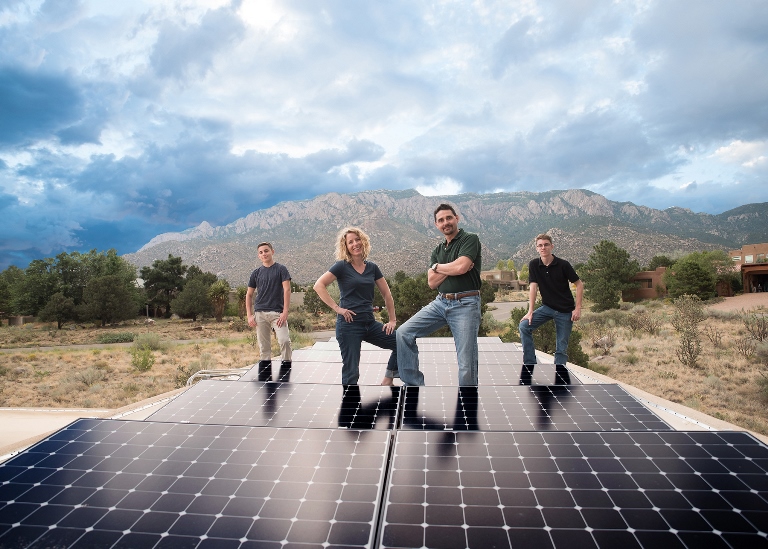
Two Main Factors
There are two main areas that solar experts evaluate: the electric bill and the roof. “The first thing to consider is that everyone is different,” said Jim. Solar is a customized plan for every home because every home and every family uses a different amount of energy. Many people try to get an idea about the cost for going solar from someone who’s gone solar themselves, but often times this can be misleading. Solar companies typically ask for energy bills from the last 12 months to estimate the amount of the energy the family uses. They can then determine how many solar panels will be needed to offset energy consumption. “The goal is to make 100% of power on the roof based on usage,” said Jim. An overabundance of energy is not necessarily a bad thing, however, the family will essentially be paying extra for unused energy. Energy providing companies like PNM only give credits, not a check, for the extra power the solar panels make. So while extra credits will roll over forever, it’s better to size the system to meet the customer’s energy demand.
The other important factor is the roof. Experts determine solar panel needs based on the direction the roof faces as well as the amount of shading on the roof. A south-facing roof with no shading provides for optimal solar panel placement. Professionals will also evaluate the roof’s condition to ensure it can support the solar power array. While solar panels are typically installed on the roof, solar companies can also do ground mounted installations or install them on a carport. For people with limited roof space, or those who think solar panels on their roof will not be appealing, these are a couple of great options.
Misconceptions
“People think that using solar panels removes them from the grid,” said Jim, but homes using solar panels are usually still connected and will continue to pay the flat rate monthly fee (approximately five dollars). Because solar panels only generate electricity when the sun is out, the power source automatically switches over to PNM when the sun goes down. Although homeowners are using PNM’s services during those nighttime hours, the credits accumulated by the solar panels that were banked during the day will typically cover the charge for the energy use at night. Everything in the home works just as it did before solar panels were installed; there are no extra buttons or switches that the homeowner is required to use in order to make the switch.
Financing and energy savings
“Most people want solar to save them money,” Pettegrew said. As we all want a greener planet, cost and money savings are the biggest factors for people considering solar. As the cost for solar is dependent upon the homeowner’s usage of energy, most people receive a return on their investment. “People enjoy the flat rate,” said Jim. People using solar energy usually only pay for their solar power system and their monthly fee from PNM. The price for owning a system is the same every month; that never changes, unlike a bill from a traditional energy provider. “People love that,” said Jim. In most cases, people are paying the same, if not less, than what they were paying their utility on a monthly basis. For most homeowners, adding solar panels does not change their monthly cost. Many solar customers choose to finance their system and solar companies partner with local lenders; there are loans available anywhere from 5 to 30 years.
Additionally, there are federal tax incentives for those who install a solar array. Homeowners can save 30%of the cost to install the solar system with no limit on the price. The tax credit can also be applied to the portion of the roof where the solar will be installed on redone. Beware of a PPA (similar to a lease) when going solar as you will not be eligible to receive the tax credits in this case.
Also consider the condition of your roof when contemplating going solar. If roof maintenance must be done after the panels are installed, the homeowner will have to pay for the solar installer to both remove and reattach the solar system. “Many homeowners get a new roof at the same time they get solar,” said Jim. Never try to remove the solar array on your own – this will void any warranty and can lead to very costly repairs.
Choosing the Right System and Professional
“Consider the manufacturer, warranty and durability,” said Jim. “This is an investment for your home for the next 25 to 40 years. This is why it’s so important that people do their research,” said Jim. Ask the installer how long they have been in business and how long the warranty for their panels lasts. Solar power is a competitive business and warranties only last as long as the company is in business. Also ask if the installer is NABCEP certified. This certification requires classroom instruction, documented experience in leading installations and the passing of a comprehensive written exam. Also ask how the company projects system output. Energy output estimates are based solely on computer-generated photos of the property and can be unreliable. Make sure you get an on-site home analysis, a documented performance of similar systems from the installer and ask for a solar resource tool to survey your home and property’s solar access. Most importantly ask about the company’s values.
SunPower by Positive Energy Solar has been installing many solar power systems around New Mexico for almost 20 years and says New Mexico is a prime location for solar energy. Above all, they say finding the right fit is the most important thing for the homeowner. Use resources like SolarReviews.com that does not allow companies to pay to have reviews written or removed. Also visit www.nabcep.org to find information on certified installers. Most importantly, meet with a professional. Jim is ready to answer all your solar questions and to provide New Mexicans with efficient and durable solar power systems.
